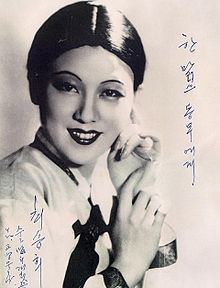Nationality Korean Other names Sai Shoki | Name Choi Seung-hee | |
 | ||
Born November 24, 1911 ( 1911-11-24 ) Seoul, Korea Died August 8, 1969, North Korea | ||
Occupation modern dancer, actress | ||
Choi Seung-hee (Hangul: 최승희; November 24, 1911 – August 8, 1969) was a leading Korean modern dancer.
Contents
Biography
Choi was born into a yangban-class family in Seoul, Korea during the colonial period, and was also known by the Japanese pronunciation of her name, Sai Shōki. Despite the Japanese policy of Sōshi-kaimei, a policy of changing Korean names to Japanese names, she retained her Korean family name of Choi. Sai is the Japanese pronunciation of the Chinese character for Choi, and was not considered Japanese.
After graduating from Sookmyung High School at the age of fifteen, she went against her father's wishes and studied under modern dancer Baku Ishii in Japan, where she distinguished herself as a talented dancer. She developed her own modern dances inspired by Korean folk dances, which had been considered as lowly works. She was supported by numerous Japanese intellectuals, including Yasunari Kawabata, and corresponded with both Jean Cocteau and Pablo Picasso. She was also a vocalist, and made recordings at Taepyeong Records and Kirin Records (in Manchukuo), before making her 1936 album Garden of Italy at Columbia Records Japan.
After the start of the Sino-Japanese War in 1937, she was sent on a tour of the front lines by the Imperial Japanese Army for propaganda purposes and to raise troop morale. Because of her use of the Japanese pronunciation of her name when she performed in the United States, she was criticized as a Japanese collaborator by Koreans in the Korean independence movement, but the Japanese government saw her as working for Korean independence, as pro-independence souvenirs were sold at her American shows.
After the end of World War II, she went to North Korea with her husband, who was an active supporter of the Workers' Party of Korea. She established a dance school and was given an official position within the North Korean administration. In 1951, she was asked to visit Beijing to perform for Chinese premier Zhou Enlai. In 1967, she was purged by the party, and disappeared from public view. However, on February 9, 2003, an official announcement was made that she had died in 1969, and a monument was constructed proclaiming her a "People's Actress". Issues surrounding her death remain unclear.
